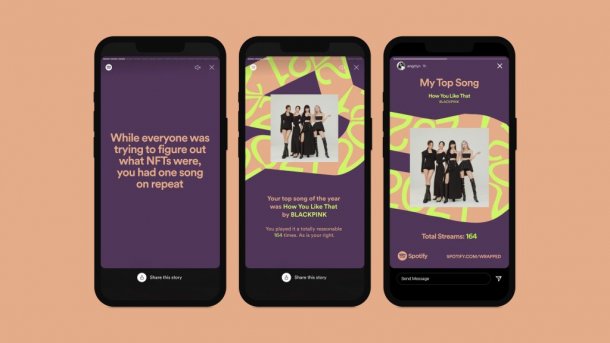26.07.2022 by Infogram
What’s a brand that you feel connected to, and why? There’s a high chance that the story they’re telling mirrors your values, beliefs, or interests. People have always connected through stories, and numerous studies prove our bond and fascination with storytelling. In a study on brain responses, researchers found out that different parts of the brain light up when we’re listening to a narrative.
Our connection to stories is what makes storytelling one of the most effective branding techniques out there. Think about Coca-Cola, Apple, Old Spice, and other successful brands – they all have nailed their brand storytelling and have made their products fascinating and appealing. It’s not about the products, it’s about the experience that keeps the customers returning.
The question is, what tools and techniques can help you convey your brand story? Also, what are excellent brand story examples you should look up to for inspiration? Let’s explore these questions together.
Click to jump forward:
What is brand storytelling?
What defines a great brand story?
Brand story examples
What is brand storytelling?
If you’re unfamiliar with this term, let’s explore it first. Brand storytelling is the act of using emotion-evoking narrative techniques to establish a value-driven connection with your customers. Emotion-evoking narrative techniques include power words like crazy, imagine, love, and hate. Visuals like different images and data visualizations play an important role in painting the picture of your brand’s story.
In short, a story humanizes your brand and makes it easier for your customers to connect with it. It applies that emotional connection to your products or services, making it a memorable experience rather than a simple exchange of goods. Most importantly, it centers your customers as protagonists in your story and allows them to participate in the narrative.
What defines a great brand story?
Many factors play a crucial role in your brand’s story. A great story consists of eye-catching visuals, compelling narratives, a hero figure, and others. Let’s explore three key factors that determine the effectiveness of a brand story.
#1 Conflict
What makes stories so compelling? There’s always a conflict that needs to be resolved or overcome. A story without a conflict or problem isn’t going to capture people’s attention. However, companies usually don’t want to share a problem they’ve dealt with. Most would rather convey a flawless image of themselves that’s so perfect at times it almost appears to be disingenuous. It’s easy to sugarcoat everything, but if you want to connect with your audience, your brand should shed the perfectionist image.

People don’t relate to perfectionism or infinite success. They relate to emotional journeys with ups and downs. People value transparency, especially from companies. Therefore, be confident in your truth and share the adversities you’ve overcome. Inspire your audience with a positive approach to a problem or conflict, and share the lessons you’ve learned. This way, your brand will become more trustworthy for your customers, and you’ll be able to create a more meaningful relationship with your audience.
#2 Consistency
Once you’ve shared your brand’s story, there’s no going back. You can’t change your story or act in a certain way that goes against the values and beliefs that you’ve shared. You have to stay consistent with your storytelling and make sure that your actions correspond to the brand story you’re trying to tell.
If your audience starts to recognize some inconsistencies, you risk losing credibility. That’s why it’s crucial to have your brand’s story reflect your values as truthfully as possible.
#3 Visuals
The way you communicate your brand’s story is crucial. When promoting your brand through social media, your website, and other channels, the first thing your audience notices is visuals.
Your visual content will ultimately carry the message for you. Ensure that whatever way you convey your brand’s story, your visual content can support it the whole way through. Also, visuals need to highlight the most important aspects of your narrative.
Not only do you have to consider what you’ll portray in your visuals, but also you’ll need to think about the color scheme, the design, how you’ll visualize data, and many other things.
To help you stay consistent with your designs, discover what Infogram has to offer. From easy-to-use templates for infographics, slides, and social media posts to convenient features like copying and pasting colors and settings. Check out all your possibilities here.
Brand story examples
Now that we have listed three key ingredients to an effective brand story, let’s look at some successful brand story examples for inspiration.
#1 Google’s Year in Search
Google has always been on top of its branding. The story-centered campaigns have spoken to millions of people and strengthened their brand. A recent high was Google’s Year in Search video, which included the most searched words and phrases of 2021. The data-driven story consisted of emotion-evoking video clips that revealed the highs and lows of 2021. Watch the video:
Portraying human emotions in a video is a powerful way to tug at one’s heartstrings. It’s natural for people to mimic and respond to other people’s emotions. As a result, people feel more connected to others and the story. This video is a perfect example of how important visual content is in storytelling. Also, notice how this story isn’t sugarcoated but includes conflict by sharing the low points people experienced in 2021.
#2 The Body Shop
The cosmetics, skincare, and perfume company were the first in the beauty industry to prioritize fair trade. They’re also widely recognized as cruelty-free, meaning that animals aren’t used to testing their products. The Body Shop’s strong values have always appeared in advertising. When people think about cruelty-free and fair trade cosmetics, The Body Shop is at the top of their minds.
Founded in 1976, the company has successfully made its place in the beauty industry and continues attracting new customers. What’s their secret, you ask? Staying consistent and placing its values and people at the forefront of its brand story has helped them strengthen their place in the market and gain trustworthy customers. On social media, they not only communicate their values but also take their followers on a journey to meet different communities that supply the product ingredients. As a result, their brand story consists of several stories from communities all over the world. Watch the video:
#3 Spotify Wrapped
Last December, were you curious to see your Spotify Wrapped? Did you share it on your social media? Many of us did. More than 90 million people engaged with Spotify Wrapped in 2020, making it a huge success.
Spotify Wrapped summarizes a listener’s streaming history for the last year. The summary includes top songs, albums, genres, podcasts, and more. All that is presented in a neatly organized way with engaging visuals, audio clips from songs, and data visualizations, making it a compelling story to watch. The data-driven narrative was highly successful because the story wasn’t about Spotify. Instead, it was about its customers. The personalized streaming history placed Spotify listeners at the forefront of the brand’s identity. As a result, the company strengthened its brand and its relationship with its customers and improved its user experience.

Making your customers the protagonists of your brand’s story is a great way to build a strong community and increase engagement. You want your customers to be your advocates. Letting them be the star of the show will motivate them to stay loyal to your brand.
#4 Nike
“[Emotional ties] builds long-term relationships with the consumer, and that’s what our campaigns are about,” states Phil Knight confidently, the co-founder and chairman emeritus of Nike, Inc., in Harvard Business Review (1992).
Nike is one of the most influential storytellers in the sports industry. And the key to their brand storytelling success has been emotion-evoking narratives that athletes can relate to. They directly speak to their audience, showcasing a range of emotions like excitement, determination, competitiveness, and others that people experience in sports.
In this advertisement, you can see sports legends like Michael Jordan and John McEnroe next to amateur athletes, competing and having fun. This ad perfectly plays into Nike’s brand story about the fitness community and that anyone can achieve amazing things with determination and the right shoes.
Brand storytelling can help you strengthen your place in the market, expand and reach your target audience, and make your products more appealing. With the right concept and tools like captivating data visualizations, social media posts, and videos, you can capitalize on brand storytelling to make it a success. If you already have an idea in mind, try out our templates to help you craft your story. Get creative!
Interested in discovering how Infogram can enhance your team’s work? Join a brief Zoom session with our Infogram representative to explore key features, get answers to your questions, and understand how we can assist. It’s quick, informative, and just like a coffee break chat. Schedule your call now!
Get data visualization tips every week:
New features, special offers, and exciting news about the world of data visualization.
